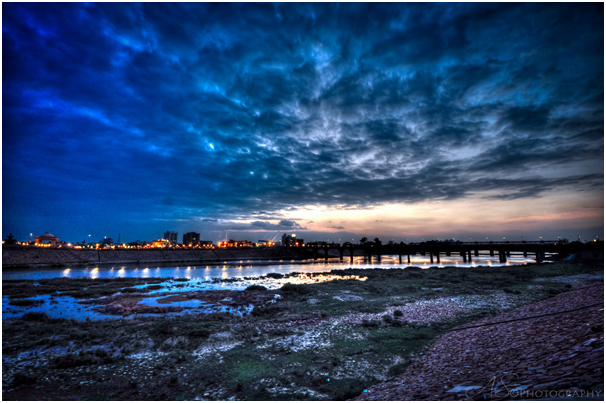Tears To Quench The Thirst Of The Gomti
Gomti River@Lucknow (Abhishek Shastri)

This is an extract from a forthcoming book on Lucknow by Mehru Jaffer
When the electricity went it carried much of their talk with it, leaving me feeling deliciously deaf and mute in the dark.
I snuggled a little closer to the circle on the wall of the cubicle that Munna Bhai called window and noticed how nothing else was visible any more between what I was able to see and the Gomti, the river that waits for the monsoons to make it pregnant.
I found her look at me staring at her, and she stirred. Then I saw her rise out of her seamless depth. Painfully she stretched out towards the empty space above her, clad in all the sins of man. Somewhat breathless from want of oxygen but still smiling, her face painted in mud, muck and mucus she perched upon a silver crescent the size of the moon as it reveals itself on the third day of every month of the lunar calendar.
As she neared I saw pieces of empty liquor and milk containers pinned to her flowing tresses. The tunic that trailed behind her dripped with poison from acts of wasteful industrial and religious rituals that continue to billow pollution into her waters in deadly proportions.
Mysteriously I watched myself step out of the four walls I sat in to meet her half way in the darkness. Once we were face to face I saw many riddles of the world revealed in her eyes. I wondered what was it that she saw in mine?
She unfolded her arms and dropped a fistful of stars at my feet. I responded by enfolding her within an embrace of my own. She smelt of hops from a nearby brewery from colonial times that had first introduced beer and hard liquor to Lucknow. Most machinery in nearby industries is outdated and does not match up to the requirements of anti-pollution laws.
I collected her deeper into my arms and decided to carry her to the stainless steel shower in my bathroom for a good scrub. The people along its banks will just have to wait for the waters to return to the Gomti, I thought.
What else can I do to protect her from over three million people who pump their excrement into her ribcage through dozens of drains and to prevent the city from taking her goodness for granted? I want to ask them if they have forgotten her worth, the very reason that she is sacred? Are they waiting for the well to dry up before they realise the value of water, or what?
On the way I exhaled smoke still clinging to her charred lap where corpses are constantly cremated on piles of wood collected from the mango grove. Each time she wriggled on the pillow made with my arm piled up beneath her ,she overwhelmed me with a whiff from a variety of refuse that has made her its home.
As we waved closer towards my bathroom we distanced ourself further from the call of bells from the many temples on the shore. The musing of muezzins at masjids also grew faint and so did the animated conversation of chataka birds with all their feathers in place and glued to tree tops in wait to welcome the first cloud.
I placed her on the hard tiled floor below the shower and twisted the knob to rain down water upon the Gomti. I found Shahnaz Herbal Shampoo to lather her foul smelling dread locks braided in dead weed and bags made of plastic. I picked away pieces of all kinds of other mechanical, animal and human waste collected in her crevices over centuries. With a cake of Mysore Sandal Soap I rubbed the sinuousness before me hard. And as I rinsed her, I discovered the sun hidden deep inside her navel.
When she began to sparkle a little I mopped the daughter of Ganga as gently as I could.
I noticed how much she resembled the almost virginal looks of her mother as she swirls in snow white drapes at the mouth of a cave deep in the Himalayas at a height of 14000 feet in the glacier covered mountain of Gangotri.
After the soak I was unable to say for sure whether the bright shine was just her glances that she repeatedly shot from side to side or were they fishes able to frisk in her waters again? I watched her also go as still as sleep, her breathing so transparent that the sulphuric depth of her basin was once again laid bare for the world to wonder over it.
This is how I imagine she must have first revealed herself more than thousands of years ago to Ram, ruler of Ayodhya from the line of the Suryavansh dynasty and seventh incarnation of Vishnu, the god responsible for preserving life. This is how pristine she must have looked with her emerald green gait flanked by sapphire blue shores.
And perhaps this is the reason why Ram is said to have chosen the picturesque hillock on the southern side of the beauteous Gomti just 200 km away from Ayodhya as home for Lakshman, his beloved brother after whom Lucknow was first called Lakshmanpur.



